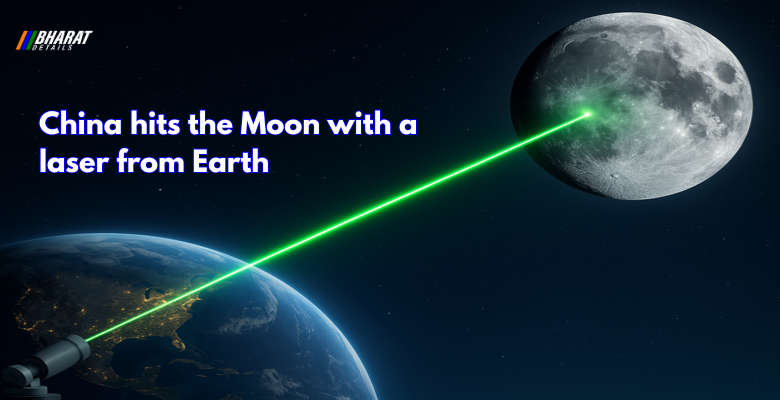China Hits the Moon with a Laser from Earth First Time Ever

China hits the Moon with a laser from Earth — and the world of space exploration may never be the same again. Imagine trying to hit a strand of hair from over six miles away. Now imagine doing it across 130,000 kilometers of space. Sounds like science fiction, right? Well, researchers from the Chinese Academy of Sciences have just made it a reality.
In a stunning display of precision and technology, a powerful infrared laser fired from Earth successfully struck a satellite orbiting the Moon. Even more impressive? This was done during daylight hours when sunlight typically interferes with laser communication. The Tiandu-1 satellite, orbiting the Moon, reflected the laser beam back to Earth in less than a second.
Let’s dive into the fascinating details of this achievement and what it could mean for the future of space travel and communication.
Contents
A Giant Leap in Laser Technology
Here’s a quick look at what China just achieved:
- 🌕 Successfully fired a laser across 80,000 miles to hit a satellite orbiting the Moon during daylight.
- 🔭 Achieved pinpoint precision, like hitting a single hair from over six miles away.
- 🚀 Part of China’s long-term plan to establish a permanent presence on the Moon by 2035.
- 🌌 Opens new doors for international space cooperation and raises questions about managing increasing space traffic.
This incredible feat was tracked by a telescope located in Yunnan, southwestern China.
Satellite Laser Ranging: Hitting a Hair in Space
Satellite laser ranging is often described as the gold standard for measuring the precise position of satellites. The technique involves firing short pulses of laser light that bounce off retroreflectors installed on the satellite, returning to Earth with vital distance data.
Typically, this technique is used for satellites closer to Earth. But hitting a satellite near the Moon, especially under the blinding light of the Sun, is a huge breakthrough.
According to researchers, the level of accuracy they achieved is like “finding a needle in a cosmic haystack.”
Goodbye Radio, Hello Lasers
Until now, most space communication relied on radio waves, which, while reliable, have limits on speed and bandwidth. Lasers are poised to change the game:
- Faster Data Transfer: Lasers can transmit information up to 100 times faster than radio waves.
- More Stability: Less prone to signal interference.
- Real-Time Communication: Imagine live conversations between Earth and a base on the Moon or Mars.
This breakthrough isn’t just about better communication; it’s about setting up the infrastructure for real-time control of rovers, robotic vehicles, and even human habitats on other planets.
Even more thrilling? In the future, lasers could potentially send power across vast distances in space.
Lasers as the Engines of Future Spacecraft
China’s success with laser targeting also hints at a future where lasers aren’t just for communication — they might power spacecraft.
Here are three futuristic propulsion methods being explored:
1. Laser-Heated Hydrogen Propulsion
A focused laser heats hydrogen in the spacecraft’s engine. The rapid expansion of the gas shoots through a nozzle, pushing the spacecraft forward. No heavy onboard fuel tanks needed!
2. Laser-Powered Ion Drives
Solar panels powered by lasers energize ion engines, propelling spacecraft by shooting charged particles at incredible speeds. Lightweight and highly efficient.
3. Laser-Pushed Solar Sails
Large reflective sails catch the force of a laser beam, just like a sailboat catches wind. Over time, these spacecraft could reach astonishing speeds—maybe even leaving our solar system!
Breaking the Daylight Barrier
One of the biggest challenges for laser communication in space has always been the interference caused by sunlight. Bright daylight would usually drown out laser signals, making them unreliable.
But with this experiment, China shattered that barrier. Their laser worked flawlessly in daylight conditions, allowing for constant communication windows and better spacecraft tracking.
This advancement brings a future where Earth-Moon communication is seamless and constant.
What This Means for China’s Lunar Dreams
China’s achievement fits neatly into its grand plans for the Moon:
- Tiandu-1 and Tiandu-2 Satellites: Supporting deep-space communication.
- Queqiao-2 Relay Satellite: Providing constant connection for Moon missions.
- Crewed Lunar Landing: Targeted by 2030.
- Permanent Lunar Base: Planned by 2035 with the International Lunar Research Station, in partnership with Russia.
Already, the Tiandu satellites have captured stunning images of the lunar surface and demonstrated successful communications across vast distances.
The Future: Managing a Crowded Sky
Following the successful 2024 launch of Chang’e-6, which brought back samples from the Moon’s far side, China is also looking ahead at the challenges of space traffic. With an estimated 100,000 satellites expected in low Earth orbit by the end of the decade, managing space traffic will become a serious concern.
China is even exploring nuclear reactors and other power sources for the lunar research station through future missions like Chang’e-8.
China hits the Moon with a laser from Earth, breaking barriers that once seemed impossible. This achievement is not just a technological marvel; it’s a giant leap towards humanity’s permanent presence beyond Earth. As lasers become the backbone of space communication and even propulsion, the dream of living and working on the Moon—or even Mars—edges closer to reality.
Stay tuned for more incredible developments in this exciting new era of space exploration, only on Bharat Details.

